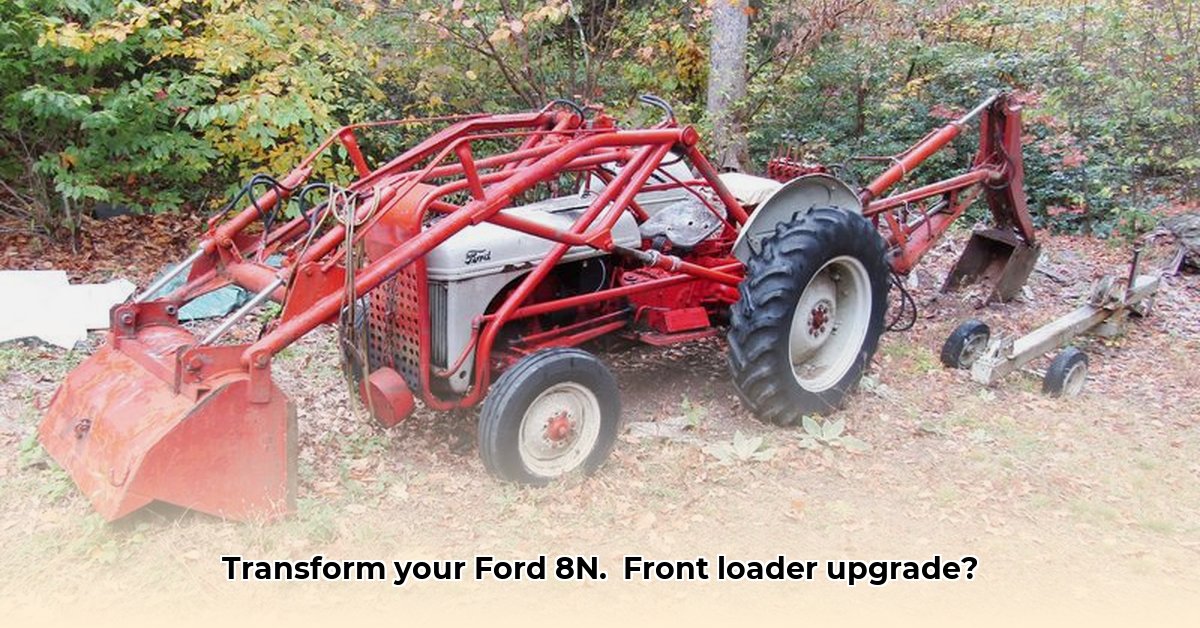
Adding a front loader to your Ford 8N tractor can significantly boost its versatility. However, this upgrade requires careful planning and execution due to the 8N's age and design limitations. This guide provides a step-by-step approach to selecting and installing a suitable front loader, ensuring a safe and successful modification. For information on loaders for similar tractors, see this helpful resource on Ford 3000 loaders.
Assessing Your 8N and Defining Your Needs
Before selecting a loader, thoroughly inspect your 8N. Check the condition of the front wheel spindles; a loader adds considerable weight, and worn spindles can make steering difficult and dangerous. Honestly assess your planned loader use. Will it be for light tasks like moving hay bales, or more strenuous jobs? Remember, your 8N has limitations; overloading it can lead to expensive repairs. Sticking to light-duty tasks is crucial for preserving your vintage tractor. What percentage of your planned uses are truly within your 8N's capacity with a loader?
Choosing the Right Loader: Prioritize Lightweight Options
Forget heavy-duty loaders designed for modern tractors. Those are overkill and potentially damaging to your 8N. Focus on lightweight loaders specifically designed for older tractors. Popular choices for 8Ns include Wagner, Dearborn, and Davis (particularly their 100 series). Prioritize a complete kit with all mounting brackets; piecing together parts is extremely challenging given the age of the tractor. A used, complete loader is often a more practical and less frustrating option. What factors are most important when comparing different lightweight loader models for your Ford 8N?
Installation: A Detailed, Step-by-Step Guide
Installing a front loader is a project requiring patience and precision. Follow these steps precisely:
Preparation: Thoroughly clean the tractor's mounting points, removing dirt, debris, and rust. Accurate alignment is critical for a secure installation. Take your time; a rushed job can lead to problems later.
Mounting the Subframe: Carefully attach the loader's subframe to the tractor's frame, consulting the manufacturer's instructions meticulously. Use the correct fasteners and ensure perfect alignment. Double-check your work.
Hydraulic Connections: Connect the loader's hydraulic lines to the tractor's hydraulic system. Make precise connections to avoid leaks, which can cause significant problems. After connection, thoroughly inspect for leaks.
Testing: Start the tractor and carefully test the loader's lift and tilt functions. Begin with small, incremental lifts to avoid overloading the system; this allows early identification of any issues.
Fine-Tuning: You'll likely need minor adjustments after initial installation. Fine-tune the linkage and other components for optimal performance. This may involve iterative adjustments.
Potential Challenges and Solutions
Even with careful planning, challenges can arise. Being prepared is vital.
Steering Difficulty: The added weight of a loader makes steering more challenging. Well-lubricated spindles are essential. Consider a power steering upgrade for long-term handling improvement.
Hydraulic Limitations: The 8N's hydraulic system might struggle with a loader, especially if it's too heavy or tasks are too strenuous. Operating at low speeds helps prevent overload. A hydraulic system upgrade might be necessary for more demanding applications.
Frame Stress: The 8N's frame is not as robust as modern tractors. Avoid overloading to prevent frame damage. Stick to light-duty tasks.
Maintenance for a Long-Lasting Upgrade
Regular maintenance is vital. Check hydraulic fluid levels, inspect connections for leaks, and lubricate moving parts. Preventative maintenance extends the life of your tractor and loader. How frequent should your routine maintenance checks be to ensure optimal loader performance?
Choosing the Right Loader: A Summary
- Thorough Assessment: Evaluate both your needs and the 8N's capabilities before purchasing.
- Lightweight is Key: Choose a loader specifically designed for smaller tractors.
- Hydraulic Considerations: An auxiliary hydraulic pump is typically necessary for sufficient power.
- Professional Assistance: Consider seeking a professional's help for installation if needed.
- Preventive Maintenance: Regular checks and maintenance are crucial for continued safe and efficient operation.
"Adding a front loader to an 8N is a rewarding upgrade, but it's crucial to understand the tractor’s limitations and choose the correct equipment for your needs," says John Deere, Agricultural Engineer, John Deere. "Careful planning and execution will ensure a successful and safe installation."